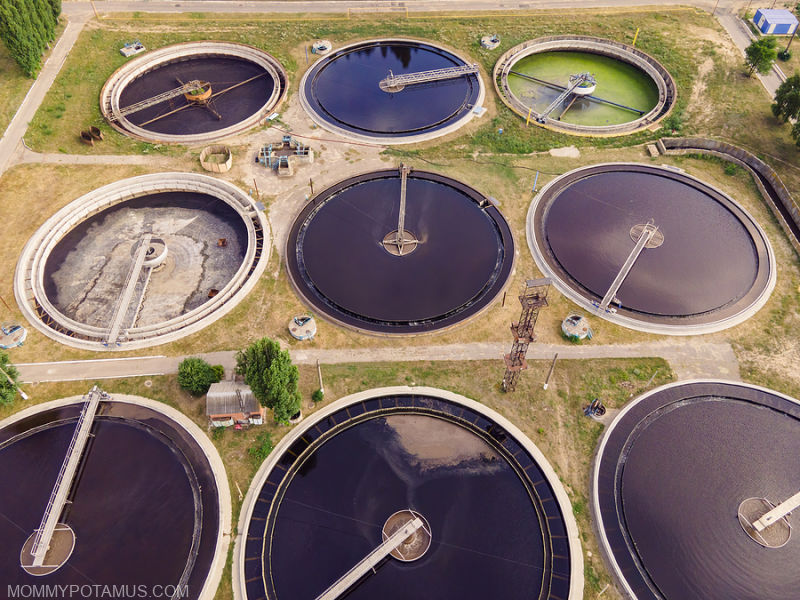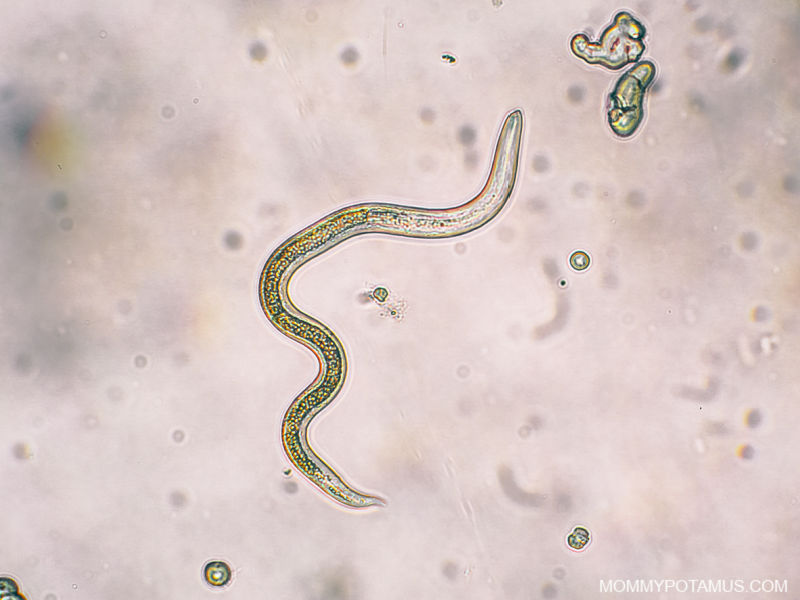
Sometimes called “The Stuff of Life,” water delivers oxygen throughout our bodies, supports detoxification, lubricates joints, keeps skin supple, helps regulate body temperature, and so much more. And because it makes up about 60% of the human body, purity really matters.
When we turn on our faucets, we don’t (usually) have to worry about dangerous pathogens that are often found in developing nations. That doesn’t mean that the water that we drink, cook our food in, and bathe in is free of harmful contaminants, though . . . not by a long shot.
In this article we’ll dive into:
- Common water contaminants
- Health effects of contaminant exposure
- How to find out what’s in your water
- Why Water Contamination Is A Growing Problem
- 4 Types of Water Contaminants & Their Health Risks
- 1. Chemical Contaminants
- 2. Biological Contaminants
- 3. Physical Contaminants
- 4. Radiological/Radioactive Contaminants
- Now for The Good Stuff
- How To Find Out What’s In Your Water
- I’m concerned about what’s in my water, now what?

Why Water Contamination Is A Growing Problem ^
Although the Environmental Protection Agency (EPA) has set limits for certain contaminants in drinking water, critics of those standards say that many of the “acceptable levels” aren’t really safe based on current research. According to The Environmental Working Group:
many of the 278 contaminants detected by local utilities’ tests are found at levels that may be legal under the Safe Drinking Water Act or state regulations but are well above levels authoritative scientific studies have found to pose health risks . . . the legal limit is often hundreds of times higher than the health standards recommended by scientists and public health agencies. (1)
Unfortunately, many community treatment plants struggle to even meet those standards – just ask the residents of Flint, Michigan (who have had dangerous levels of lead in their water supply for years) or the 6 million people living in eight states who found out they’d been drinking uranium contaminated water that far exceeded EPA maximum levels.
That’s not the only concern, though: In addition to the harmful stuff we’re already aware of, the EPA has identified over 100 “contaminants of emerging concern” that include:
nanoparticles, pharmaceuticals, personal care products, estrogen-like compounds, flame retardants, detergents, and some industrial chemicals” that are likely to have a “potential significant impact on human health and aquatic life.” (2)
Included on that list are “forever chemicals” such as PFAS – which is a chemical that doesn’t break down and therefore bioaccumulates in our bodies – plus neurotoxins, endocrine disruptors, and likely carcinogens.
Even more problematic is the possibility that the EPA may only be looking into a tenth of the contaminants that are out there. According to this network or laboratories and research centers, the number may be closer to 1000.
Only a small fraction of these chemicals of concern are monitored and/or regulated in any way, which means that it’s up to consumers to address them while regulations catch up. It’s been nearly 20 years since the EPA has added any contaminants to the list of chemicals covered under the Safe Water Drinking Act.

4 Types of Water Contaminants & Their Health Risks ^
When the Environmental Working Group reviewed drinking water reports from nearly 50,000 water companies or utilities nationwide and then compared the test results with science-based health guidelines, they found:
- 93 chemicals linked to cancer
- 78 chemicals linked to brain and nervous system problems
- 63 contaminants that can harm development of a fetus or young child
- 38 contaminants linked to human fertility problems
- And at least 45 contaminants linked to hormone disruption (3)
So what exactly are these contaminants? In general, they fall into four categories:
- chemical
- biological
- physical
- radiological
Different filtration methods remove different types of contaminants, so it’s important to identify the specific concerns for your area when shopping for a water filter.
1. Chemical Contaminants ^
Chemical contaminants can be naturally occurring or man-made. Although not an exhaustive list, here are some of the most common ones to be aware of:
Pharmaceutical Drugs
Water treatment plants are not required to monitor levels of pharmaceuticals, and though we’ve known for a while that trace amounts were making it into our drinking water, testing from the Environmental Protection Agency found higher numbers than expected. (4)
Using samples from 50 wastewater treatment plants, they tested for 56 different drugs including oxycodone, high-blood pressure medications, anti-seizure medications like carbamazepine, and beta blockers like metoprolol and atenolol.
More than half of the samples tested positive for at least 25 of the drugs.
Drugs get into the water supply in one of two ways:
- When consumed, unmetabolized drugs are excreted from the body via urine
- Sometimes unused drugs are flushed down the toilet
Although some argue that they are only “trace amounts” and not dangerous, no one has actually studied the biological impact on humans, and negative effects have been seen in fish and aquatic life at lower levels than anticipated.

Lead
- In children, lead exposure can cause decreased IQ, hyperactivity, behavior and learning problems, slowed growth, anemia, and hearing problems.
- In adults, it can cause increased blood pressure and hypertension, decreased kidney function, and reproductive problems in both men and women. (5)
- Unfortunately, even when municipal water tests free of lead, millions of Americans have lead pipes that carry municipal water into their home. In those cases the lead exposure happens after the water is tested and is therefore not detected. “If your home was built after 1988 with a new water connection, you can be confident that you do not have a lead service line. If your house or property first got water service before 1988, there is a chance you may have a lead service line, even if your home was remodeled or replaced later.” (6)
Arsenic
- Occurs in naturally high concentrations in the groundwater of certain areas. Despite regulatory standards, there are still “hotspots” that exceed the national maximum contaminant limit. (7)
- “Long-term exposure to low levels of inorganic arsenic in drinking water is known to cause human health problems including: cancer, thickening and discoloration of the skin, problems with blood vessels, high blood pressure, heart disease, nerve effects including numbness and/or pain, and interference with some important cell functions.” (8)
Hexavalent Chromium (Chromium 6)
Unlike chromium 3 which is a beneficial mineral, chromium 6 is a highly toxic group 1 carcinogen. It’s sometimes called the Erin Brockovich chemical because it was made famous by her advocacy.
Other toxic heavy metals
Heavy metals including antimony, cadmium, mercury and others can also be found in drinking water as a result of naturally occuring deposits and agricultural runoff/industrial pollution.
According to this study, health issues related to drinking water contaminated with heavy metals “may include cardiovascular disorders, neuronal damage, renal injuries, and risk of cancer and diabetes.”
Fluoride
Fluoride is a known neurotoxin, and a research collaboration between Harvard’s School of Health and China Medical University in Shenyang “found strong indications that fluoride may adversely affect cognitive development in children.” (9)
Several studies have found lower IQ levels in children exposed to fluoridated water, while this study found a 284% increase in ADHD-like symptoms. (9)(10)
A large 2015 study done in England also found that fluoridated water may also increase the risk of developing hypothyroidism, which can lead to symptoms such as fatigue, weight gain and depression. (11)
About 1/3 of U.S. cities don’t fluoridate their water, but some of those cities do have high levels of naturally occurring fluoride. It’s best to check if you need a fluoride filter before buying one.
Important Note: In the past water treatment facilities added sodium fluoride to water, so this is what most fluoride filters are designed to remove. However, these days two new forms of fluoride are more commonly used – fluorosilicic acid and sodium fluorosilicate – and many standard fluoride filters don’t work on them. (12)
Chlorine, Chloramines & Their Byproducts
Chlorine is a powerful disinfectant that is used to kill bacteria and harmful microorganisms, while chloramine is another type of disinfectant that is made by mixing chlorine with ammonia.
Both create disinfection byproducts such as trihalomethanes (TTHM – chloroform, bromoform, bromodichloromethane, and dibromochloromethane) and haloacetic acids (HAA5 – monochloro-, dichloro-, trichloro-, monobromo-, dibromo-).
According to the National Institute of Health (NIH), there is some concern that these byproducts may increase cancer risk. (13) (14)
Chloramines can also offgas into the air and cause respiratory issues.
Although they do the same thing, you can’t use the same type of filter to remove both chlorine and chloramine. Some remove both, but be sure to check that if yours doesn’t that it does filter the one your city uses.
Volatile Organic Compounds (VOCs) & Forever Chemicals
I’ve written before about the health effects of VOCs and why not of of them are dangerous. The same is true of waterborne VOCs, but there is one difference – they don’t have the distinct taste and/or smell associated with their airborne counterparts.
The Environmental Working Group categorizes twelve common VOC water contaminants as carcinogenic. They are:
- Vinyl chloride
- Benzene (from gasoline)
- Styrene
- 1,2,3-Trichloropropane
- 1,1,2-Trichloroethane
- Tetrachloroethylene (both PCE and PERC)
- Trichloroethylene (TCE)
- 1,4-Dioxane
- 1,2-Dichloroethane
- Carbon tetrachloride
- 1,2-Dichloropropane
- Dichloromethane (methylene chloride)
Other VOCs are not known to cause cancer but can be toxic to the liver, kidneys or nervous system and/or cause thyroid problems, immune system problems, and more.
Some of these – perfluoroalkyl substances (PFAS), for example – are sometimes called “forever chemicals” because they don’t break down and bioaccumulate in our bodies.
Pesticides & Industrial Byproducts
From agricultural runoff, industrial pollution, and product-based contaminants such as flame retardants.

2. Biological Contaminants ^
This category includes parasites such as cryptosporidium and giardia, bacteria such as E. coli, protozoan, viruses and algae. Although for the most part chlorine and chloramines kill biological contaminants before they reach us, there are times when some break through.
If testing reveals the problem a county will usually issue a boil notice to consumers to let them know the water is not safe. However, there have been cases when pathogens such as E. coli, norovirus and giardia have made it into the public water supply.
3. Physical Contaminants ^
If you’ve ever poured a glass of water that is very cloudy, you may be seeing physical contaminants such as silt, sand, rust or clay. Together these contaminants are called sediment, and they’re generally harmless but can cause problems for some plumbing systems.
Water filters often come with a pre-filter that removes sediment.
4. Radiological/Radioactive Contaminants ^
Natural radiation comes from cosmic rays, naturally-occurring radioactive elements in the earth’s crust, and radioactive decay products. Since these radionuclides are present in soil and rock, they can also be found in groundwater and surface water.
Radionuclides are radioactive isotopes that can occur naturally or result from manmade sources. Natural radiation comes from cosmic rays, naturally-occurring radioactive elements in the earth’s crust, and radioactive decay products. Since these radionuclides are present in soil and rock, they can also be found in groundwater and surface water. Typical radionuclides found in drinking water sources are isotopes of radium, uranium, and radon, among others. Fission products from manmade nuclear reactions are also of concern today, particularly radioactive cesium and iodine.” (15)
Now for The Good Stuff ^
Fortunately, our water comes with good stuff, too, particularly minerals including:
- Calcium
- Copper
- Iron
- Magnesium
- Manganese
- Phosphorus
- Potassium
- Sodium
- Zinc

How To Find Out What’s In Your Water ^
Now that we’ve taken a deep dive into what CAN be in drinking water, let’s talk about how to find out what IS in your drinking water. This is the absolute first step before choosing a water filter, because it will help you figure out what type of filter is needed to remove the things you are concerned about.
If you’re on municipal water, here are some things you can do:
Get a copy of your local water quality report. You can usually do this by googling the name of your city, your state and “water quality report.” Clearly Filtered also has helpful tool that can pull your report and help you better understand what the most concerning aspects are.
However, though this report will give you some helpful information, keep in mind that prescription drugs and many “chemicals of emerging concern” are unregulated by the EPA, so they’re not usually listed on water quality reports.
Sometimes you can reach out to your local water supplier and request a more detailed report that will list unregulated chemicals.
Also, find out if your water supplier uses chlorine or chloramines. As mentioned earlier, both serve as disinfectants but they’re filtered out differently. Your water quality report should tell you this, but some suppliers switch back and forth so it doesn’t hurt to call and ask if what’s on the report is what they use all year.
Additional Testing Options
National Water Testing Laboratories is an independent, certified water quality testing service that is one of the most respected in the industry. They offer a Water Check Deluxe Test that looks for:
- 20 heavy metals and minerals
- 7 other inorganic chemicals
- 4 physical characteristics
- 16 disinfectants and disinfection by-products including chlorine, chloramine, trihalomethanes and haloacetic acids
- 47 volatile organic chemicals (VOCs)
- 20 pesticides, herbicides and PCBs
Also, as mentioned above, even if your local water tests low for lead when it leaves the treatment facility, sometimes it can pick up lead via service pipes leading into your home. If that might be the case, there are are inexpensive at-home test kits that can check for it.
If you’re on well water:
- The Centers for Disease Control recommends that you test “once each year for total coliform bacteria, nitrates, total dissolved solids, and pH levels. If you suspect other contaminants, you should test for those as well. However, spend time identifying potential problems as these tests can be expensive. The best way to start is to consult a local expert, such as the local health department, about local contaminants of concern. You should also have your well tested if:
- There are known problems with well water in your area
- You have experienced problems near your well (i.e., flooding, land disturbances, and nearby waste disposal sites)
- You replace or repair any part of your well system
- You notice a change in water quality (i.e., taste, color, odor)”
- You can call the EPA’s Safe Drinking Water Hotline (800-426-4791) to find out if your local municipality provides inexpensive or free testing.
- Another option is to order a National Water Testing Laboratories test kit that is created specifically to test for common contaminants in well water. You can find it here. The Deluxe Well-Check tests for:
- Bacteria (Coliform and E.Coli)
- 22 heavy metals and minerals
- 7 other inorganic chemicals
- 5 physical factor
- 4 trihalomethanes
- 47 volatile organic chemicals (VOCs)
- 20 pesticides, herbicides and PCBs

I’m concerned about what’s in my water, now what? ^
I’ve put together a water filter buyer’s guide that covers the pros and cons of different types of filters, plus detailed guides for each category once you decide what’s best for your goals and budget:
- Best Countertop Filters
- Best Under Counter Water Filters
- Best Whole House Water Filters
- Best Shower Filters
Want more research-backed natural remedies?
No problem, I’ve created a free ebook for you – Kitchen Apothecary: 25+ Natural Remedies Using Ingredients From Your Pantry – as a gift for signing up for my newsletter. You’ll also get updates when I post about safe essential oils for pregnant/breastfeeding mamas, exclusive gifts and coupons (I was able to give away a jar of free coconut oil to anyone who wanted it recently!), plus other goodies.
Sign up using the form below.
Sources
1. Environmental Working Group (2019) The Dirty Secret of Government Drinking Water Standards
2. United States Environmental Protection Agency. Chemicals of Emerging Concern in the Columbia River
3. Environmental Working Group (2017) Drinking Water and Children’s Health
4. United States Environmental Protection Agency. Concentrations of Prioritized Pharmaceuticals in Effluents from 50 Large Wastewater Treatment Plants in the US and Implications for Risk Estimation
5. United States Environmental Protection Agency. Basic Information about Lead in Drinking Water
6. NDRC (2020) How Can I Find Out If I Have a Lead Service Line?
7. Columbia University (2020) Study Uncovers Hotspots of Arsenic in Drinking Water
8. Michigan Department of Environment, Great Lakes and Energy (2019) Arsenic In Well Water
9. Harvard School of Public Health (2012) Impact of fluoride on neurological development in children
10. Xu, Kaihong et. al. (2020) Fluoride exposure and intelligence in school-age children: evidence from different windows of exposure susceptibility
11. Newsweek (2015) Water Fluoridation May Increase Risk of Underactive Thyroid Disorder
12. Centers for Disease Control & Prevention (CDC) Types of Fluoride Additives
13. National Institutes of Health Division of Cancer Epidemiology & Genetics. Drinking Water Contaminants
14. Massachusetts Department of Environmental Protection (2018) TTHM in Drinking Water: Information for Consumers
15. Cape Fear Public Utility Authority. Radionuclides





This is all stuff that I have *sort of* known but put on the back burner. I think it is time to move it to the front. 🙂
Great post Heather!! People are never aware of all the things that are floating around in their tap water. Another good book (older, but really good) that talks about this is by a medical doctor named Sherry Rodgers called “Detoxify or Die”. This is where I first started researching everything we don’t know about tap water. Great series this week though, thanks for posting!
We have Well water but still use our Big Berkey for everything, drinking, cooking, watering plants, their shower filter too! Should we be ok?🤞 I’m a pregnant nurse with 3 kids and have been following you and Katie Wells for 10 years, you are an inspiration, and I’m so grateful.🙏